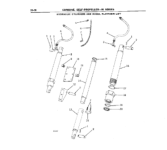So, to add another wrinkle to this, a cylinder WILL drift down.. if down is cylinder extension.
I just repaired this condition on my backhoe's boom. Bad seal on OD of the piston.
I believe the reason for this is that it's relatively easy to suck air into a cylinder through the gland seal because the gland seal is a directional lip seal that only really has the power to seal pressure in one direction. In cylinder retraction when the rod end is pressurized, that pressure is pushing the lip seal against the cylinder rod, causing it to be able to seal against higher pressure. Without that pressure the directional seal is actually fairly weak. I have witnessed this in another way on bucket curl cylinders with leaking glands. When you curl the bucket up and the rod end is pressurized, the glands would leak a little or not at all, BUT if you slowly dumped the bucket fluid would GUSH out of the gland seal because there was no real pressure in that area helping it seal. If you dumped the bucket quickly it would seal better because you were generating some pressure in the rod end trying to squeeze all that fluid out the small hose fitting. I rebuilt those glands, didn't touch the pistons, and those cylinder seal up perfectly now. So this factor of the directional lip seal relying on pressure in the rod end to seal up can even be observed in extension, in certain cases.
Anyway, in the other direction the only thing keeping the gland seal from allowing AIR into the cylinder is the tension of the seal material to the shaft, and the shaft condition. If you've ever slid a gland onto a cylinder rod you get an idea how much that is (a bit, but not much) and if the rod has any surface damage in that area air will certainly flow across it.
So if the cylinder is in extension, a leaking piston seal CAN allow the cylinder to extend, because it will suck air into the gland to make up for the greater internal volume. It happened to my backhoe, I replaced a piston seal, NOT the gland seals, and it fixed it.


